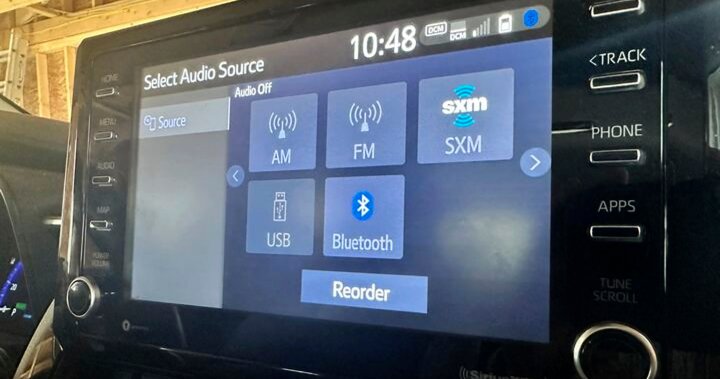Listening to the radio in a car is almost as old as the car itself. When American inventor Lee DeForest demonstrated his cutting-edge technology, it was at the 1904 World Fair in St. Louis that everyone demonstrated the operation of new, fangled wireless devices. It worked, but this was a proof of concept problem that was on most people's heads, as the right radio stations have not existed for at least several more decades.
By 1922, commercial radio had been catching up, and several inventors were keen to install receivers in their cars. An amateur named George Frost performed a radio show he did at Mache in the Ford Model T. They were very bulky, ran on very fragile vacuum tubes and were very expensive. Transitone costs $150 (about $2,300 for today's money) if you can buy the entire car for under $700. Electrical interference from the car's ignition system was also a major issue.
A big breakthrough was in 1930 when William R. Lear (yes, the Learjet man and the first promoter of the 8-track player) who worked with Elmer's Shaking (one of his employees and inventor of the car alternator) to meet with the electronics manufacturer's owners Paul and Joseph Galvin.
Entertainment details more videos
Together, they built a radio for Paul's Studebaker. It was big and bulky – all the controls were mounted on the steering column – but it worked and sounded good. Galvin then drove it to a radio maker convention in Chicago, parked outside, cranked it up, and was flooded with orders for his “Motorola.” (Yes, the same people who are currently in the mobile phone business.) It was still expensive – $110 – but it was the first useful and practical car radio.

Get daily national news
Get the top news, political, economic, and current events headlines of the day, delivered once a day to your inbox.
As technology improved, solid state circuits replaced vacuum tubes in the 1950s, and in 1952 the introduction of in-dash FM radios, but it was hard to imagine a vehicle without a radio to keep you awake on entertainment, news, dating and long late-night drives. It's free, local, and when done correctly, it feels like the person on the other side of the speaker is riding with you. Even today, about 80% of listening in-cars is radio.
Today, infotainment systems are deeply integrated into automotive systems, offering all kinds of listening options and connectivity. The radio is still there but needs to compete with many other options and features.
When I travel, I like to rent cars from different manufacturers and see what they do with infotainment. I was frustrated when I found a radio feature on multiple occasions. Why would someone fill the radio?
The good news is that there are a lot of pushbacks. Around 200 senior executives from around the world gathered at the WorldDab Automotive 2025 Conference in Madrid to convey this message. Otherwise, the driver will miss out on a lot – and the radio itself can be fatally suffered by lack of exposure.
AM Radio is under siege, but it seems that Congressional acts will be needed to keep it alive in the car (spoiler: AM Radio is still needed) – FM Radio is still strong. Other countries use DAB (digital audio broadcast) radio. This is a form avoided by the US, killing opportunities in North America. Norway, Switzerland, and several other countries have either completely abandoned FM radios or are in the process of all-in with DABs. And then of course there is satellite radio. It's mostly from North America, but has tens of millions of listeners.
Trend now

Fans criticize Beyoncé for shirts that call Native Americans “enemies of peace.”

All the charming celebrities see from Jeff Bezos, Lauren Sanchez's wedding
This is a comment from Edith Takdra Chova, the head of radio at the European Broadcasting Association. “The radio was always there for us in our car. We're such a beloved and very trustworthy companion. I can't imagine we could fill the gap if we disappeared from the dashboard.
And this comes from Stephen Mellor, president of the European Radio Association. “We need to work together as an industry and work with the automotive industry to maintain radio within the car, which is important from a safety standpoint.”
These stations, including the BBC, Radio France, NRJ (France), Global (UK), Bauer (UK), RTL (Luxembourg), Radio Hamburg (Germany), Australian commercial radio and audio, and the country's RCA engineering groups, are behind a new international initiative called Radio Ready. There are three pillars. 1) Radios should remain prominent and convenient on the dashboard, 2) Radio-related apps should be easy to find, 3) Audio assistants should be able to provide access to radio content. It's hard to find and use traditional broadcast radios, and nothing that's risky.
The more international pressures apply to manufacturers (and software suppliers like QNX in Canada, Apple CarPlay and Android Auto), the more radios are protected within the infotainment system. Other broadcasters have been invited to participate in the movement.
This is from Tobias Nielsen of Bauer Media Group in the UK. “The cultural values radio offers are essential to democracy and public safety in emergencies, which are accessible, prominent and easy to discover in connected cars in the future.”
There is no argument from me. Let's add one more. Broadcast radio is free. No subscription required. As entertainment media progresses, it's not as friction as it gets.
I hope this will turn into a global movement.
Curator Recommendations

Best Early Prime Day deals you won't want to miss

Prepare your outdoor cooking with these top picks
&Copy 2025 Global News, a division of Corus Entertainment Inc.

